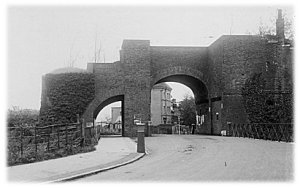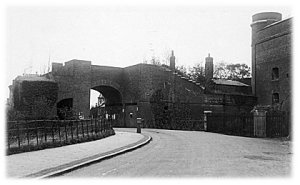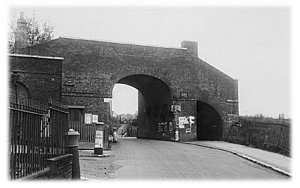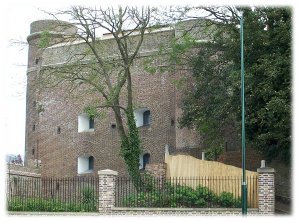THEY are probably the most interesting homes in the Medway Towns.
 Fort Clarence, built as part of the defences against an expected Napoleonic invasion, has now been turned into apartments.
Fort Clarence, built as part of the defences against an expected Napoleonic invasion, has now been turned into apartments.
The fort, which overlooks the Medway from St Margaret’s Street, has seen much of the towns’ recent military and naval history — but little active service.
Work on the fort started in 1808 and was completed in 1812.
It was positioned to repel any attack from the river and stop invaders from going up either St Margaret’s Street or the Rochester-Maidstone Road.
These magnificent pictures show the archway that once spanned St Margaret’s Street, near the Willis Memorial Gardens. Its demolition in 1924 removed an expression from the local lexicon. “Going up the arches”, in the argot of those who lived in Bishop’s Square and below, meant going towards Borstal.
 All that remains is the red brick keep, not unlike a smoothed-down model of a medieval castle, which was a gun tower and observation post.
All that remains is the red brick keep, not unlike a smoothed-down model of a medieval castle, which was a gun tower and observation post.
Through the arch, just out of sight in these views, was a drawbridge that joined the huge ditch that still runs down nearly to the river.
From the tower ran a series of tunnels to outlying guardhouses. I explored one as a youngster.
Napoleon, of course, never invaded. So a new use had to be found for Clarence after Bonaparte met his Waterloo.
Initially, it became a military prison and lunatic asylum. Fort Pitt was then converted to a military hospital and the Clarence patients were moved there, leaving their old home as solely a jail.
The fort was used as a recruiting centre in the First World War and a TAVR (Territorial Army) centre was built nearby soon afterwards. (In the late 1960s, I recall a VI Doodlebug was on show outside the centre. Does anyone know what happened to it?)
 The Home Guard (33 Battalion), under the command of Lieut-Col J M Prower, used Fort Clarence as headquarters in the Second World War (does anyone have pictures of them that I could borrow?) and Short Brothers built an underground aircraft factory nearby. I have seen photographs of this secret installation and hope to feature it soon.
The Home Guard (33 Battalion), under the command of Lieut-Col J M Prower, used Fort Clarence as headquarters in the Second World War (does anyone have pictures of them that I could borrow?) and Short Brothers built an underground aircraft factory nearby. I have seen photographs of this secret installation and hope to feature it soon.
The fort served as the Home Guard’s HQ, training centre and stores until it was disbanded in December, 1944. During that time, the cell block was turned into an ammunition store and the chapel into a gymnasium.
Fort Clarence became derelict after the war and GPO telephones used the site, demolishing the barracks on the Maidstone Road side. There was also a Maidstone Road guardhouse, somewhere near the old football pitch at the foot of Ethelbert Road — does anyone have pictures of that?
The Governor’s Residence
RIGHT next to the old keep is Fort Clarence House, once residence of its governor, now a private family home.
The family have been collecting as much information as they can upon their interesting next-door neighbours and are particularly interested in the local worthies who lived in her house.
The front of the house is probably 17th Century, but the back was rebuilt in 1810 at the same time as the fort. Captain Manners, chief surgeon at the fort asylum, lived there in 1858.
By 1867, when the fort had become a jail – with accommodation for 150 prisoners – Major Hume-Edwards was in residence as governor. During this era, flogging was still a common punishment and soldiers were often seen being marched up St Margaret’s Street for sentence to be carried out.
 On the way back, they were allowed to march with their tunics draped over their backs — so that the material would not chafe their beaten and bloodied arms.
On the way back, they were allowed to march with their tunics draped over their backs — so that the material would not chafe their beaten and bloodied arms.
Lieut-Gen George Wentworth Forbes of the Royal Marines, who came next, became something of a local figure and his death in 1907 was recorded with due solemnity in the Rochester, Chatham and Gillingham News.
Forbes, a city magistrate, also became known as a fine orator in his role as chairman of New Brompton Conservative association. His funeral was “of a simple character, in deference to the expressed wish of the gallant officer”.
Later came Capt Francis Emberton, of the Royal Army Ordnance Corps, who had served in the Zulu War of 1879, the Egyptian campaign of 1882-6, the relief of General Gordon, and the South African War.
While the fort lay derelict, the governor’s home remained in use to house senior army officers. After the GPO bought the fort, the house remained empty until 1977 when it was sold.